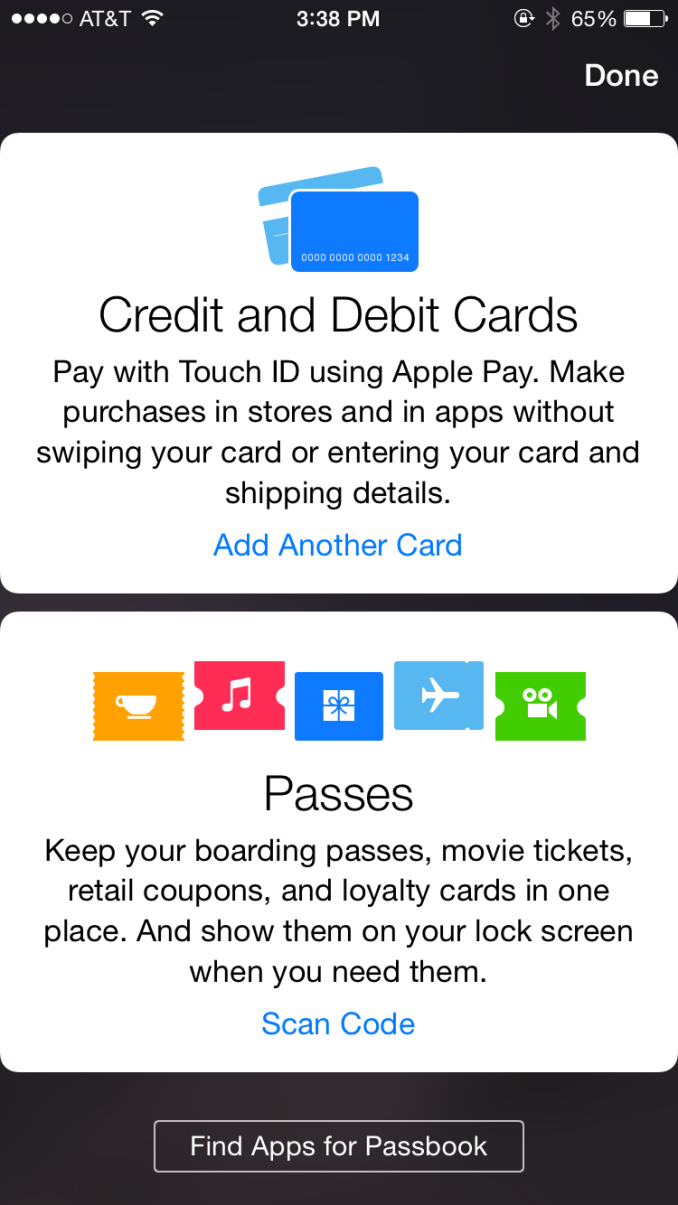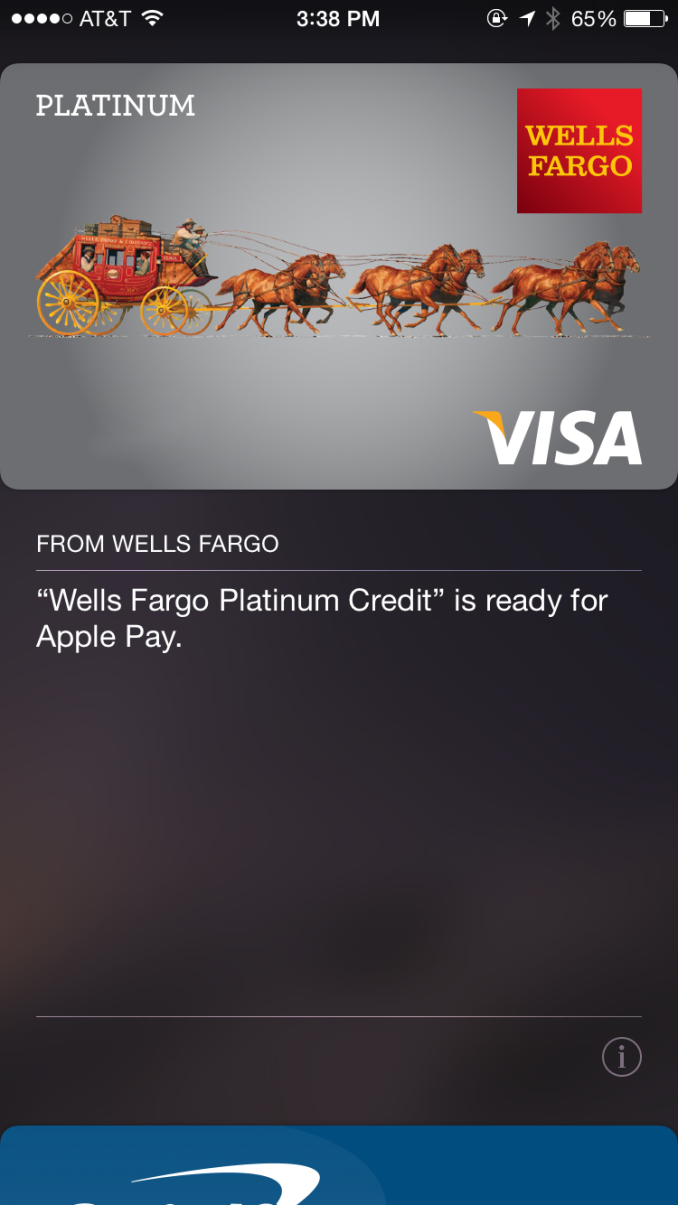A Look At OS X Yosemite And iOS 8.1
by Brandon Chester on October 27, 2014 8:00 AM ESTApple's Foray Into Payments
Apple has made two announcements this year that show an expansion into areas outside of the technology industry. The first was Apple Watch, which is most definitely a technology product but looks positioned against the current premium watch industry just as much as against current smartwatches on the market. The second was Apple's foray into the payment industry, Apple Pay. While Apple Watch won't be around until next year, Apple Pay is here right now with one caveat. Apple Pay currently only works in the United States, or more specifically, only with a credit card issued by a United States bank. However, the service will eventually be expanded to support cards issued by banks in other countries.
How Apple pay works is fairly straightforward, that's the entire point of it. If the region on your device is set to the United States, the passbook app will contain a card that allows you to add a credit or debit card. You can then either type your info in, or use your camera to get the information from the card. Once the card is verified by your bank, you will have a card that appears in passbook and you're ready to start using Apple Pay. From the user's perspective, Apple Pay is simple and easy to use. But what goes on behind the scenes to keep everything secure can be quite complicated.
Security
The first thing to know is that your credit card information is never stored on the phone. Upon adding a credit card, the information is encrypted and sent to the appropriate issuing bank which confirms that the card is valid. A token is then sent back to the iPhone and stored in the secure element, which is essentially just an internal smart card chip. This token, not your credit card number, is what is used during payments. Apple's marketing and technical material refers to it as a Device Account Number. The token itself resembles a credit card number, but the only similarity between it and your card is the 4 digits on the end.
The use of tokens is where much of the security of Apple Pay comes from. By removing the actual credit card number from the equation, the merchant you're paying never gets to see your credit card number, security code, or your name. The token presumably is also only linked to the actual credit card via some database held by the bank, rather than some sort of equation that could be reverse engineered. This means that even in the event where a merchant is hacked and your token number shows up, it is entirely useless because it does not function as a credit card and is tied to the iPhone it was used on.
Beyond the overarching security, there's additional security at the time of payment. It begins with the use of Touch ID for authorizing payments. Although Touch ID launched with the iPhone 5s which does not have the necessary NFC hardware to use Apple Pay, I believe that this sort of service was the original goal when Touch ID was first being created. Paying with Apple Pay requires using Touch ID to verify your fingerprint. This prevents anyone from making purchases using your iPhone if it is lost or stolen.
One thing to note is that Apple Pay is not just a service for making purchases in stores. It also works for making purchases at online retailers than integrate it into their applications. All the security features that I've described apply to both in-store and online purchases, so there's no compromises on either side.
Going Forward
Making Apple Pay successful is going to take a lot of work on both Apple's part and on the part of retailers. Currently the service only works with cards from US banks, leaving out the rest of the world. Apple needs to expand the service much quicker than competitors have done so with theirs. For example, Google Wallet remains a US only service over 3 years after its initial launch. Apple Pay is not going to achieve success if it ends up in the same situation. Apple has given no timeframe for expansion to other countries, but if the iPhone 6 and 6 Plus get replaced by newer models before Apple Pay expands outside the US it will be a worrisome situation.
Apple also needs to convince retailers to support the service. The list of supported merchants on the Apple Pay section of their website has grown since its initial launch, and if Apple Pay is ever going to be a viable way to make everyday purchases that list needs to continue to grow. Work by banks to increase adoption of NFC capable terminals will also speed up this process, as Apple Pay works with existing NFC enabled checkouts. Apple also faces resistance from retailers that are partnered with other payment systems. Recently there have been reports that merchants who support the CurrentC mobile payment standard are disabling NFC on the payment terminals in their stores to block Apple Pay. I don't believe this will be an issue in the long term because consumers will realize when companies are prioritizing their own agenda over the customer's experience and they'll go to other retailers. If Walmart won't support Apple Pay and a customer wants to use it, they'll just go to Target instead.
As someone who doesn't live in the United States, I'm hopeful that the service will expand to Canada before this iPhone becomes obsolete. There are many obstacles in the way, but Apple appears to have put more effort into working with banks and merchants to get the service off the ground than any of the other mobile payment services we have today. How things play out will only be revealed with time.












173 Comments
View All Comments
Brett Howse - Monday, October 27, 2014 - link
You can actually tether to a Windows Phone from the laptop without touching the phone - just like the Apple method it connects to the phone over Bluetooth and then turns on the hotspot. So yes to that one.But no to everything else they need to do more work on integrating the experiences of phone and desktop.
andrewaggb - Monday, October 27, 2014 - link
well microsoft tablets run windows, so they basically have the same capabilities. They do have smartglass for the xbox which allows browser transitions between tablet and xbox (works with an ipad as well). I don't have a windows phone.I know the playto feature to play movies and stuff to the xbox one and 360 (and other dlna players) works great.
SkyDrive sync's your windows profile/files etc across tablet and pc.
It's not perfect by any stretch, but there's definitely integration. I use the same billing account for my microsoft azure cloud services as I do for my xbox, it's all tied to my microsoft account. As was a purchase from the microsoft online store.
The sms and call transferring stuff is cool though, hopefully they grab that as well. Windows media center integration with the xbox 360 was great, but unfortunately that product is gone.
Bob Todd - Monday, October 27, 2014 - link
Ah cool! One feature down. I really hope they put an emphasis on tying all of their big offerings together (desktop/phone/tablet/Xbox/etc.) in meaningful ways like that.DarkXale - Monday, October 27, 2014 - link
1) Yes.2) Theres a standard bluetooth profile for that; started doing it in the feature phone era. This is old even on Apple's side.
3) Yes again. See point number two. Feature phones sometimes required their 'Suite' software for this to work fully.
Impulses - Friday, October 31, 2014 - link
Does the Bluetooth profile actually pair the phone via Wi-Fi tho? Tethering over Bluetooth itself would be kind of a bottleneck if you have a particularly good LTE connection... I remember tethering over just BT back on the day with my netbook and Sony Ericsson phone, didn't have to turn anything on in the phone either, but this was back before 3G!HisDivineOrder - Monday, October 27, 2014 - link
I think Apple's incentivizing of staying in their ecosystem is interesting for the user who will do that or has the money to do it. That said, I think Google started the ball rolling and Microsoft has joined now too with a lot more emphasis than even Google at making broad compatibility across lots of platforms, which I think is probably the better way forward.Apple is a devices company. It's obvious. Google is a marketing company and so they emphasize their services as a way to get more info to use for marketing. Microsoft wants to be both Apple and Google, but Nadella seems keen to focus Microsoft on the Services part of that equation, which is wise because their devices just won't sell very well save for some high end Surface tablets to some ultra niche customers.
I think Microsoft's approach of making their services envelop other platforms so if you have an Android phone and a Windows PC and an iPad, you can use all your platforms to see OneDrive or Office 365 is the most convenient one for the typical consumer with the typical budget.
I think Apple's way is the most convenient one for Apple and the few people who have the budget to afford all Apple devices and the Apple Tax that goes with them.
odedia - Monday, October 27, 2014 - link
Guys, when is the iMac retina 5k due to appear? It's the one thing keeping me from ordering it.Ryan Smith - Monday, October 27, 2014 - link
Next week.Anandrian - Monday, October 27, 2014 - link
I think the article is spot on."You can only use the whole apple ecosystem if you have apple hardware/software"
Take full advantage of the ecosystem, yes! but that's the apple way. They control every aspect of the ecosystem to guarantee a better than average experience and I think they've succeed.
"OS X Yosemite not innovative"
That may be so, but it is damn good even if it's not innovative. At this point in time the improvements or new features might not be ground breaking but when you used them regularly you can really understand the advantage of them. This also is true for windows 8.1, some people hate it and some people love it and in my own experience, I like what win 8.1 brings to the table the way I use it.
"Apple is expensive"
Yes it is, is it worth it? I guess that's personal. I do have a 2009 13" macbook pro and it's still working fine with OS X Yosemite (I did upgrade my HDD to an SDD an the memory from 4GB to 8GB almost since I bought it). And I also have an awesome watercooled pc with win 8.1 which I built myself, I use it for programming and gaming and it is awesome!. I really like both machines however I do have an iphone and an ipad and I like what the apple ecosystem brings to the table, would I like it to have more features? yes, of course but that will come with future iOS and OS X releases just as it will happen with Microsoft and Google and all the other players out there.
Don't hate guys! just enjoy :D
mfenn - Monday, October 27, 2014 - link
"I had never used it until Yosemite rolled out with the new capabilities that Apple had built in."What??? How did you launch applications before?